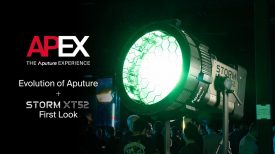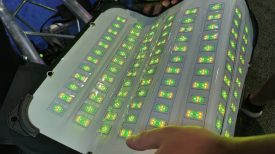
When the Ursa Mini was launched in 2015 it seemed Blackmagic Design had finally made a camera with a useable form factor. On paper the specs were incredible for the price, but sadly its usability for ENG and doco type work was ultimately limited. The omission of accessible controls while on the shoulder and the lack of built in NDs for mixed lighting conditions made it feel like a camera that could only really be considered for feature type productions or situations where you had considerable control over your shooting circumstances.
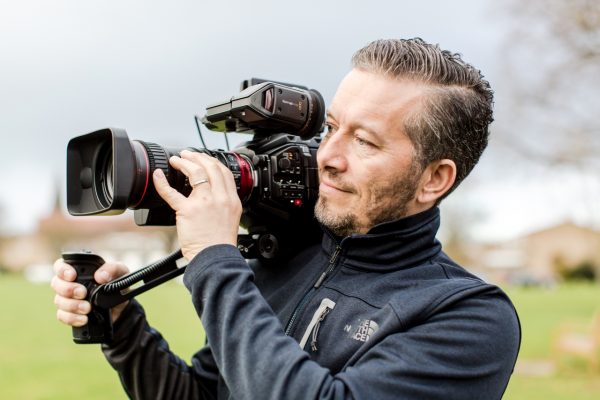
The recent launch of the Ursa Mini Pro suggests Blackmagic has really made an effort to listen to its customers requests and further develop the Ursa Mini line into a much more usable camera for a much greater variety of shooting situations. I was interested to look at these new improvements to see how they can make the camera attractive for a wider range of scenarios.
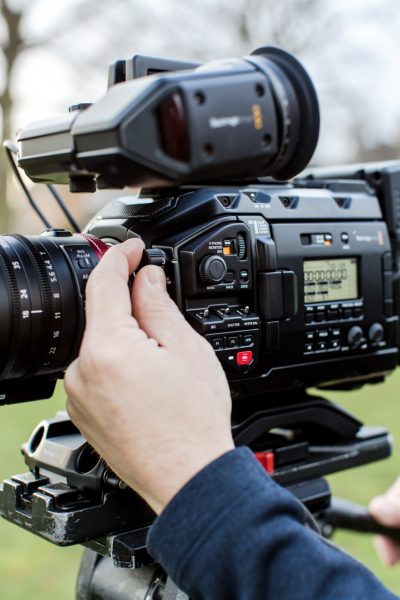
4.6K, now with added ND
While the 4.6K sensor remains the same, the standout improvement over image control on the URSA Mini Pro is the very welcome inclusion of an internal ND wheel. This gives not only 2,4 and 6 stops of ND but also infrared light pollution control (something the original URSA Mini suffered from, causing some customers to send theirs back). It really was a big disappointment that these were omitted from the original camera, and now that they have been added, it makes the camera usable in a greater variety of lighting conditions.
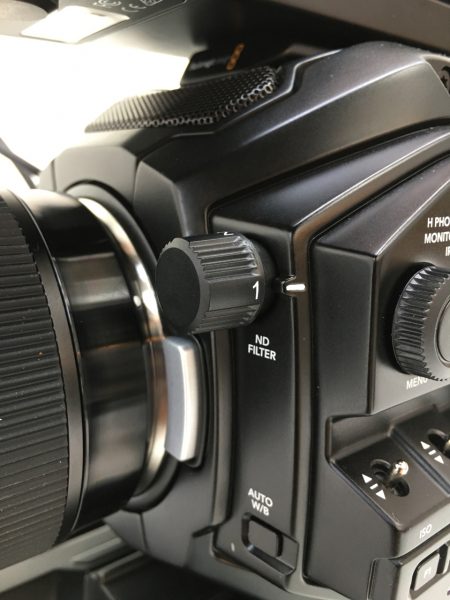
The ND filter wheel is located in the traditional ENG position, and the stops are labeled 1,2,3,4 – 1 being clear and then 2,4,6 stops respectively. Different manufacturers express NDs differently, but it really doesn’t take long to get used to, and if you forget the numbers/stops, they are labelled on the side of the camera. The mechanical wheel has a nice solid feel in operation and each ND clicks securely into position. As you move between NDs they are indicated in the viewfinder or LCD screen – but oddly that indication only remains on the screen for a few seconds before disappearing.
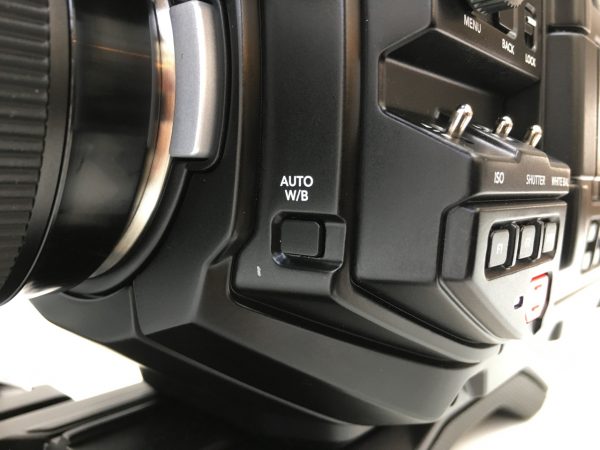
Below the ND wheel you’ll find an auto white balance button – press this for a few seconds and you can set your white balance instantly using a white/grey card. It’s really nice to be able to have this easily accessible on the front of the camera especially if you’re moving around in mixed lighting conditions.
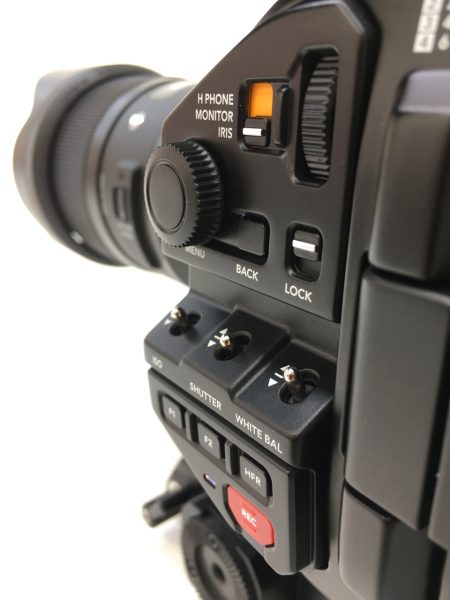
Layout and controls
As far as the control layout is concerned, I think sense has finally prevailed, and we find some actual tactile camera controls for shoulder mount shooting. Firstly there are three toggle switches which will feel familiar to anyone who has shot with 2/3” shoulder mount cameras, particularly Sonys. There is a reason why they were implemented and remain on so many cameras: they are simple and easy to find and use when the camera is on your shoulder. The toggle switches give access to three important camera settings – ISO, shutter and white balance, and it’s very easy to cycle up and down through these settings. The ISO can be set to 200,400,800 & 1600, white balance from 2500K to 10000K (in 50k increments) and shutter angle from 11.2° to 360° (It looks like you can view this as a shutter speed, although the camera I tested had this option greyed out).
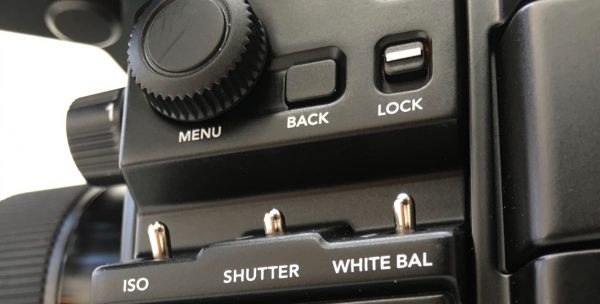
Above the toggle switches there is a multifunction press/rotate dial labeled ‘Menu’ which gives you access to some camera and display functions while you’re using either the Blackmagic EVF or another EVF/monitor connected to the front SDI out. You can scroll through camera and monitor settings such as ISO/shutter/WB, and also assist settings such as framing guides, zebra, peaking functions and false colour. To access these functions you press the dial and turn it to scroll through, there is a ‘back’ button next to the wheel to escape from each function.
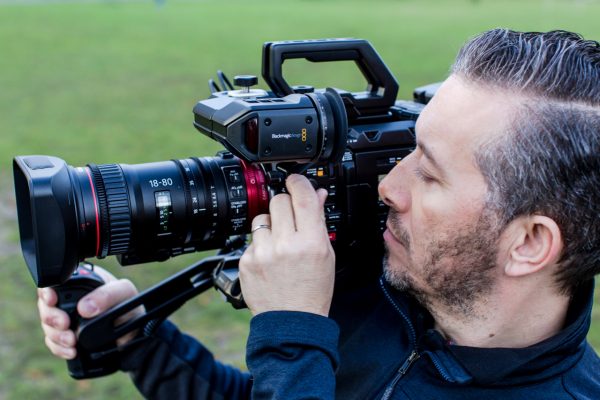
While on the shoulder this dial is very easy to find, the back button less so as it has a panel lock switch next to it, but like all the switches and buttons on this new panel the more you use the camera the more likely that muscle memory will help you find these controls. Although this dial is labeled as ‘Menu’, it does only give access to limited camera functions and not the full menu which is a shame. The dial doesn’t show up on the main LCD either, you need to press menu on the camera itself and use the LCD touchscreen to access the complete menu. I think this dial has real potential to access a greater number of camera functions, hopefully this could be opened up on a future firmware update.
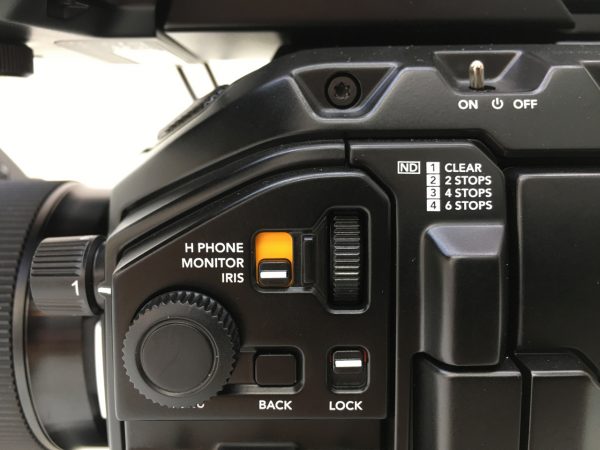
Above the menu dial is another multifunction and switchable dial labeled headphone/monitor/iris. The iris control is the most useful function here if you are using electronically controlled lenses such as EF glass. It has a smooth action, and is easy to find and use when the camera is mounted on your shoulder. It can get slightly obstructed though when you are using the LCD screen tilted at an angle.
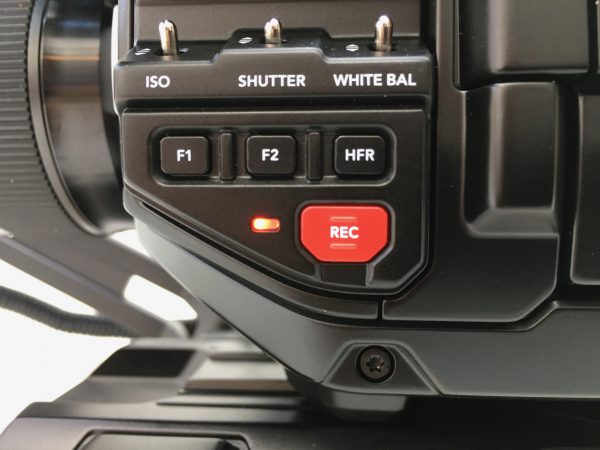
Right at the bottom of this new feature set of controls are two preset buttons F1 and F2, which can be given several assignments such as false colour, frame guides, zebra, display on/off, and colour bars. These are conveniently located and give you quick access to a number of functions. Next to these is the ‘HFR’ button which gives you instant access to swap between standard and high speed frame rates so you can easily switch between 30/60fps at 4K for example or even 30/120fps (windowed) in HD/2K. For the HFR button to switch to 120fps you need to already have the camera set in the windowed sensor mode. If you are shooting 4.6K you can set the HFR button up to 60fps. Again this is really useful feature to have if you are running around with the camera on the shoulder and want to quickly swap frame rates.
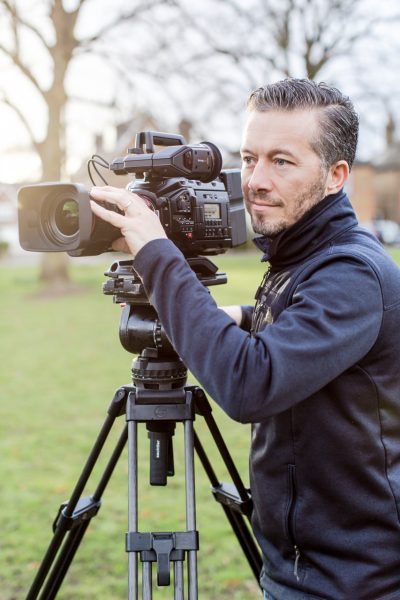
Finally at the very bottom of this panel is a bright red REC button and a small tally light. This is the only record button on the camera (apart from the hand grip) when you have the LCD screen closed, but the placement is perfect for handheld or tripod use. Next to it is a tally light that glows white when the camera is on, red when in record mode, and flashes yellow when your battery is low.
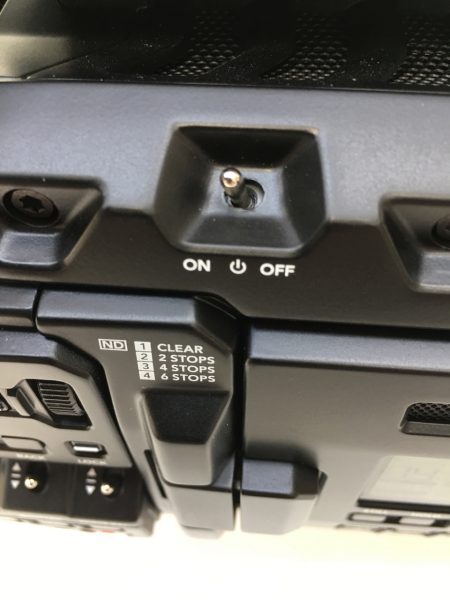
The power on/off is now a toggle switch the camera body above the LCD hinge.
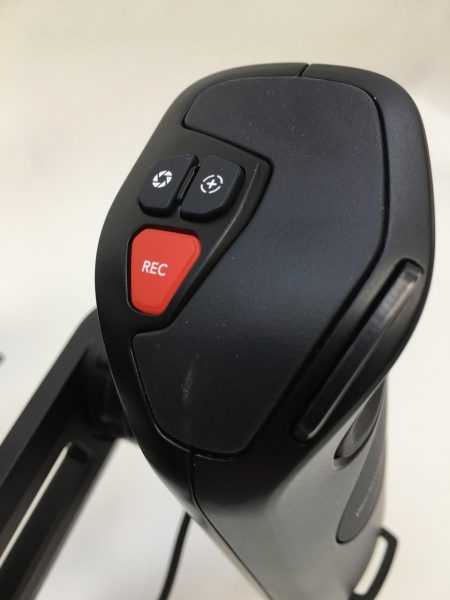
Handgrip, LCD
The Blackmagic handgrip remains the same with just record and iris functions. I would have liked to have seen this further developed, maybe with the addition of a control dial or mini joystick like that on the Canon C300.
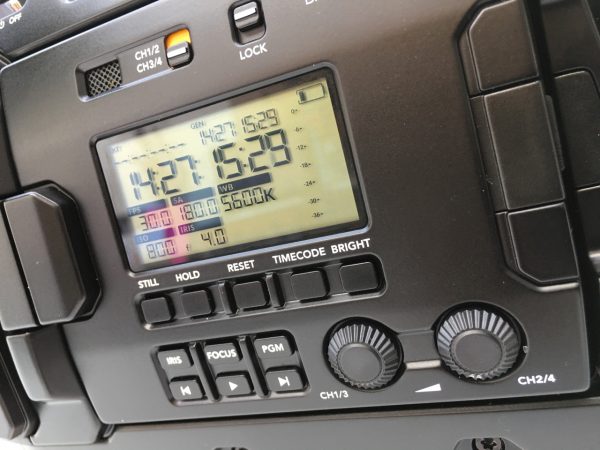
The other major change from the original Ursa Mini is the new slightly smaller LCD touch screen and a dimmable backlit black and white screen on the other side to show critical camera info when the LCD is folded away. With the LCD folded there are a number of function buttons accessible and these include timecode, camera controls such as iris, playback buttons, audio controls/switches for the four channels of audio including two audio control dials.
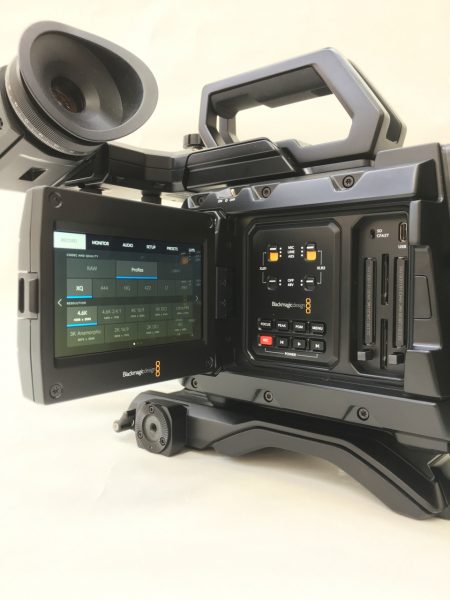
Audio controls and Media Slots
When you open up the screen there are more audio controls, and another set of camera controls, including a menu button. You’ll also find no less than four card slots – two CFast and two SD, the latter meaning that you can take advantage of much less expensive recording media if you are recording at lower resolution and don’t need super high data rates. It is frustrating that even with four available slots, there is no way of recording lower bitrate proxies to one of the SD cards, while recording RAW to the CFast. For a company that sells a lot of post production equipment to make workflows easier, it seems like a strange thing to have not included.
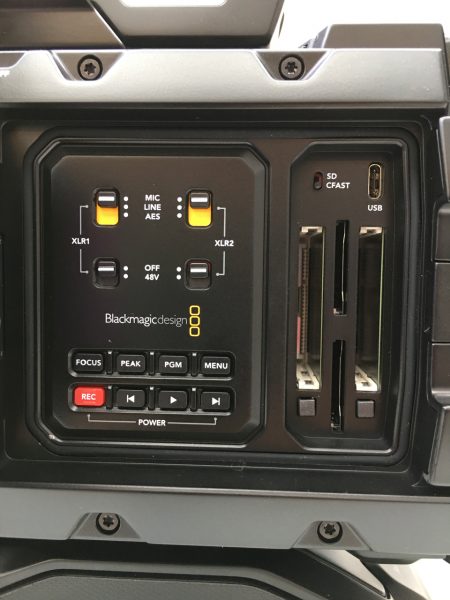
If you want to take advantage of the cameras high end resolution and codecs then you’ll need to use CFast cards which are currently very expensive , which is worth bearing in mind when pricing up the camera and all the bits you need to get it working properly.
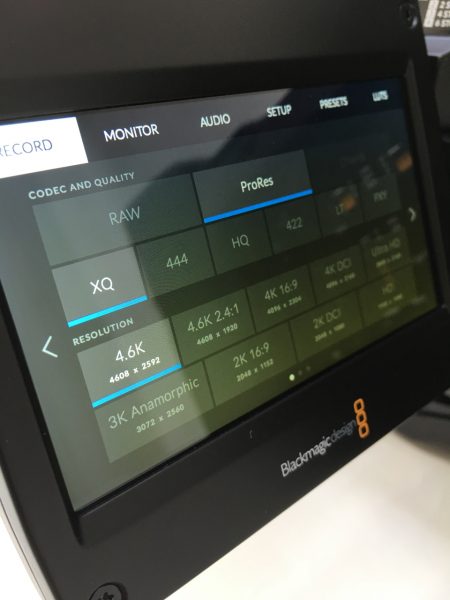
The LCD screen is slightly smaller but still of excellent quality. I loved using the LCD screen on the first Ursa Mini, and coupled with the excellent peaking, I found it really easy to find focus. The easy to use menu system is also very intuitive and user-friendly (something that took Blackmagic a long time to get right).
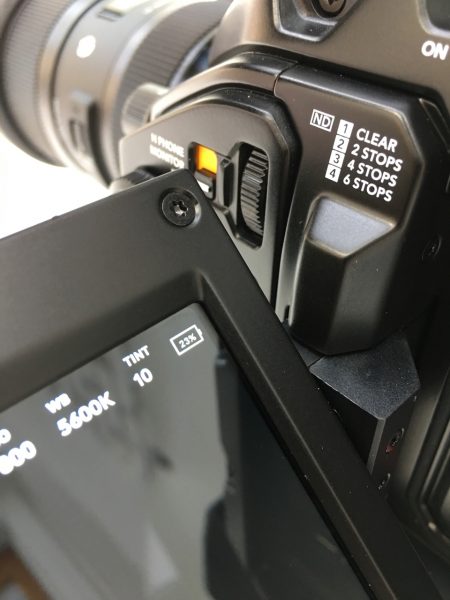
LCD: could do with more rotation
One thing I really wanted to see on the development of this camera was for for the LCD screen to have the ability to rotate 360 degrees. I’m personally not bothered about using it for selfies but some people such as Vloggers would have certainly found this function attractive. I wished they had enabled the screen to fold back into the camera and still view the LCD and operate the menu functions. Personally I feel that had this been enabled there would have been no need to add the additional B&W screen on the other side. You can’t look at both of them at the same time anyway and this just feels like over-engineering. On Sony’s old DSR450 camera the side screen could be switched between the video output and camera function displays with a press of a button it’s a shame they couldn’t have made it more like that. One thing I still love about Canon’s C300 is the ability to see the screen from so many angles which is particularly useful when working with a track & dolly or a jib and being able to view the LCD from the side of the camera would have been a real bonus.
Blackmagic could have placed some of the controls around the screen if required, added a lock button, and relocated the audio pots to somewhere more accessible on the camera. Their current placement means they are against your neck when you are using the camera shoulder mounted.
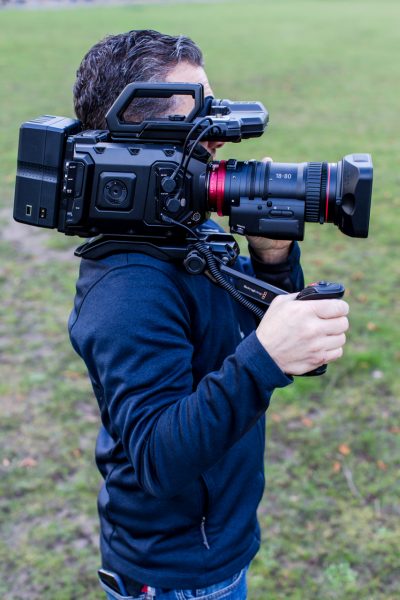
Choose your own lens mount
Finally one more killer feature Blackmagic have added to this camera is the ability for the user to swap lens mounts. Quality lenses are seen as a good investment that you can use on a variety of different cameras. By implementing a user changeable mount that allows for the use of many different lenses, Blackmagic have made the Ursa Mini Pro a much more versatile camera. This really is a very compelling reason to purchase this camera, especially if you’re an owner-operator who works on a wide range of productions. Perhaps you own EF glass and use that for most of your productions, but occasionally want to up your game and rent some quality PL mount primes, or a versatile B4 lens for a run and gun doco shoot, well now you can. The lens mounts are also very affordable and Blackmagic’s mounts are actually cheaper than some of the third party adapters out there. There’s also a Nikon mount in the works if that’s your bag. As this camera was on loan to Newsshooter from Blackmagic, there wasn’t any other lens mount provided, so we weren’t able to field test how easy they are to swap over.
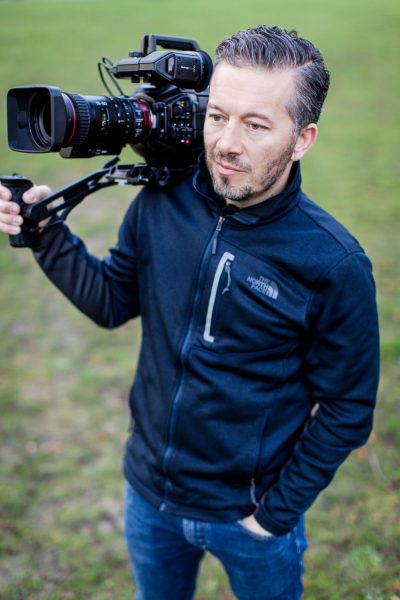
Room for improvement
There’s certainly a lot to like about the Ursa Mini Pro, but there are still some negative aspects:
*The Blackmagic viewfinder kept dimming randomly even when you had your eye next to it, this is something I previously experienced using the older URSA Mini.
* I was surprised that the camera would let you switch between 25p and 60p i.e. to record different television standards on the same card. Also there is no 50/60i if you happen to need to shoot interlaced which a lot of people working in television still do.
*I couldn’t find any timecode settings in the menu.
*Some of the buttons on the side are not at all clear, in fact even after using the camera for quite a few days, I still haven’t worked out how to set the timecode.
*There seems to be no timecode output from the camera so if you are using two cameras and you want to the lock them together you’d have to look at the lockit box or something similar.
*There seem to be lots of buttons that repeat the same functions.
*The handgrip and extension bar are a bit of a missed opportunity. There is limited functionality on the hand grip, and the extension bar isn’t not long enough and has no quick release.
*Camera seems quite power hungry, compared to other cameras such as the Canon C300 and Sony FS7.
*This is no low light king by any means, and with a max 1600 ISO you could easily run out of light/lens stop in a doco style situation.
Conclusion: The Mini goes Pro
In conclusion this feels like a solidly built camera, just like the Ursa Mini, but a much improved version. There still are further improvements that I think could be made, and the camera is far from perfect. While the image quality is going to be the same at the Ursa Mini 4.6K, the operational aspects of using the camera have drastically improved over the original Ursa Mini. The Mini Pro sits and works very nicely on the shoulder, something that perhaps the original Ursa Mini wasn’t so good at. The added features and design make it much more versatile for a greater range of shoots and even with the added accessories you’ll probably need, such as the Blackmagic EVF and baseplate, it still comes in at an incredibly competitive price for its feature set.



